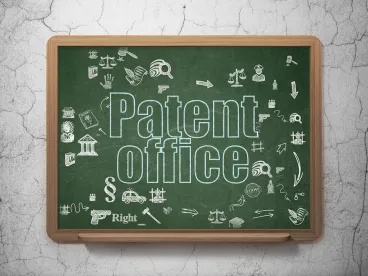Filing an appeal brief with the Patent Trial and Appeal Board (PTAB) can be an effective way to advance prosecution and secure allowable claims. After an appellant’s filing of a PTAB appeal brief, an examiner may respond with an examiner’s answer. 37 C.F.R. §§ 41.37, 41.39. The appellant then has a choice to allow the appeal to proceed to the PTAB or to first respond to the examiner’s answer in a reply brief. 37 CFR § 41.41. The examiner is entitled to introduce new grounds of rejection in the examiner’s answer, which the appellant may rebut in the reply brief. The USPTO recently issued guidance, “Responding to New Grounds of Rejection in an Examiner’s Answer,” which we summarize below in addition to providing other related useful tips.
-
Identify the new ground of rejection: As indicated by the USPTO, what constitutes a new ground of rejection is “a highly fact-specific question,” and the ultimate criterion is “whether appellants have had fair opportunity to react to the thrust of the rejection.” New grounds of rejection are often easily identifiable in the examiner’s answer since any evidence applied or cited for the first time in an examiner’s answer should be designated, per 37 CFR § 41.39, as a new ground of rejection. A more elusive new ground of rejection is a position or rationale that changes the “basic thrust of the rejection,” which the examiner’s answer should also identify as a new ground of rejection. The examiner’s answer may, however, fail to designate a new ground of rejection as such due to inadvertent oversight and/or another reason. Careful review of all rejections in the examiner’s answer, including consideration of the basic thrust of each rejection, is thus prudent practice.
-
Situations that constitute new grounds of rejection: The USPTO provides examples of what will be treated as new grounds of rejection: changing the statutory basis of rejection from § 102 to § 103, changing the statutory basis of rejection from § 103 to § 102 based on a different teaching (e.g., reliance on a different portion of the same reference), citing new calculations in support of overlapping ranges, citing new structure in support of structural obviousness, and pointing to a different portion of the claim to maintain a “new matter” rejection.
-
Situations that do not constitute new grounds of rejection: The USPTO also provides following examples of what will not be treated as new grounds of rejection: citing a different portion of a reference to elaborate upon that which has been cited previously, changing the statutory basis of rejection from § 103 to § 102 but relying on the same teachings, relying on fewer than all references in support of a § 103 rejection, changing the order of references in the statement of rejection but relying on the same teachings of those references, and considering, in order to respond to appellant’s arguments, other portions of a reference submitted by the appellant.
-
-
Know your options for response: An appellant must respond to a new ground of rejection within two months from the date of the examiner’s answer. Otherwise, claims subject to the new ground of rejection will be dismissed. Depending on specific circumstances of the case, two options are available to respond to the new grounds of rejection. The first option for response is to request that prosecution be reopened, by filing a reply under 37 CFR § 1.111, with or without amendment or submission of affidavit. The second option is to maintain the appeal by filing a reply brief that addresses each new ground of rejection.
-
Determine whether the examiner properly identified the new ground of rejection: A new ground of rejection in the examiner’s answer must be prominently identified in the answer with a subheading “New Grounds of Rejection.” If an appellant determines that the answer includes a new ground of rejection that is not so designated, there are again two options to respond. A first option is filing a reply brief responding to the examiner’s answer, to maintain the appeal. The second option is filing a petition to the USPTO Director seeking a review of the examiner’s failure to designate a rejection as a new ground. The petition should be filed without filing a reply brief, and it will toll the time period for filing a reply brief.
-
Know the effects of filing a petition: If a petition to designate a new ground of rejection in the examiner’s answer is granted and prosecution is reopened, the cost of preparing and filing a reply brief can be avoided altogether. If the petition is denied and the appeal is maintained, the appellant will have two months to file a reply brief. Thus, the petition to review the examiner’s answer should be filed only if the reopening of prosecution, rather than to maintain the appeal, is a desirable outcome. At the same time, if maintaining the appeal happens to be desired after the petition is filed but before it is decided, a reply brief can be filed, which will be taken as a request to withdraw the petition and to maintain the appeal.
-
Be careful not to inadvertently reopen prosecution: When writing a reply brief with intent to maintain the appeal, remember that no amendments, affidavits, or other evidence tending to prove or disprove the existence of an alleged fact may be submitted in response to a new ground of rejection. Such action will be treated as a request to reopen prosecution regardless of whether or not the reply brief requests the reopening of prosecution. Also note that, according to 37 CFR § 41.30, “evidence” is “something that tends to prove or disprove the existence of an alleged fact” and does not include dictionaries.
-
Know consequences of taking no action: A possible way to react to an undesignated new ground of rejection in the examiner’s answer is to take no action, with the appeal simply proceeding to the Board. However, such “no action” action may lead to an undesirable outcome. For example, if a petition to review the examiner’s failure to designate a new ground of rejection is not filed, this will be taken as a waiver of any arguments with respect to the examiner’s failure. When a reply brief is not filed, the PTAB will only receive the examiner’s side of the story for an undesignated new ground of rejection and may thus be more likely to deny patentability of the claims based on the undesignated new ground of rejection.




 />i
/>i

